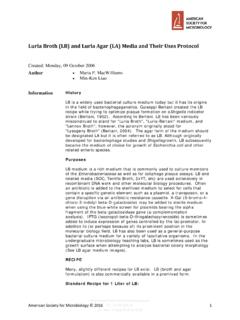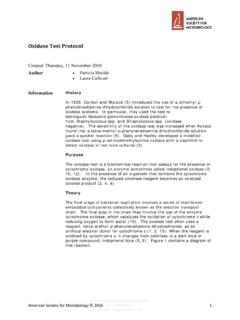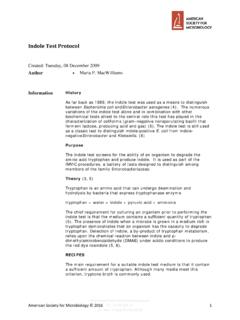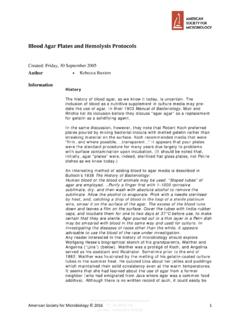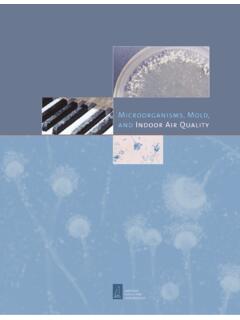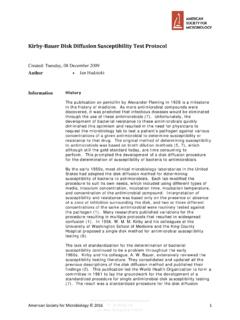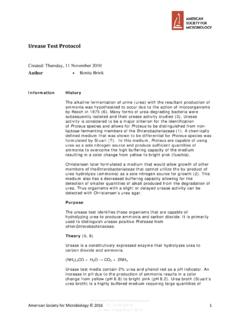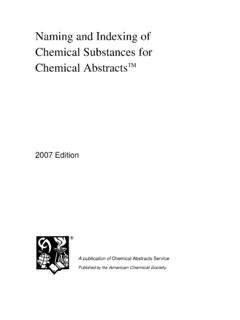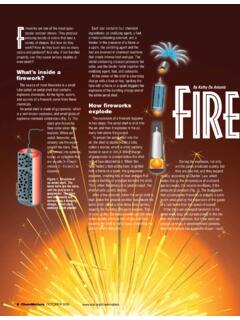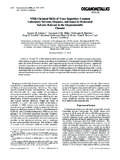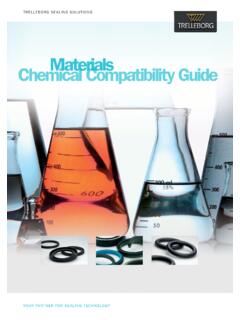Transcription of Gram Stain Protocols - American Society for Microbiology
1 Downloaded from byIP: : Mon, 12 Aug 2019 17:45:19 American Society for Microbiology 2016 1 gram Stain Protocols | | Created: Friday, 30 September 2005 Author Ann C. Smith Marise A. Hussey Information History The gram Stain was first used in 1884 by Hans Christian gram ( gram ,1884). gram was searching for a method that would allow visualization of cocci in tissue sections of lungs of those who had died of pneumonia. Already available was a staining method designed by Robert Koch for visualizing turbercle bacilli. gram devised his method that used Crystal Violet (Gentian Violet) as the primary Stain , an iodine solution as a mordant followed by treatment with ethanol as a decolorizer. This staining procedure left the nuclei of eukaryotic cells in tissue samples unstained while the cocci found in the lungs of those who had succumbed to pneumonia were stained blue/violet. gram found that his Stain worked for visualizing a series of bacteria associated with disease such as the cocci of suppurative arthritis following scarlet fever.
2 He found however that Typhoid bacilli were easily decolorized after the treatment with crystal violet and iodine, when ethanol was added. We now know that those organisms that stained blue/violet with gram s Stain are gram -positive bacteria and include Streptococcus pneumoniae (found in the lungs of those with pneumonia) and Streptococcus pyogenes (from patients with Scarlet fever) while those that were decolorized are gram -negativebacteria such as the Salmonella Typhi that is associated with Typhoid fever. You may read the original publication of the staining procedure in the translated article "The Differential Staining of Schizomycetes in tissue sections and in dried preparations". Purpose The gram Stain is fundamental to the phenotypic characterization of bacteria. The staining procedure differentiates organisms of the domain Bacteria according to cell wall structure. gram -positive cells have a thick peptidoglycan layer and Stain blue to purple. gram -negative cells have a thin peptidoglycan layer and Stain red to pink.
3 Theory The gram Stain , the most widely used staining procedure in bacteriology, is a complex and differential staining procedure. Through a series of staining and decolorization steps, organisms in the Domain Bacteria are differentiated according to cell wall composition. gram -positive bacteria Downloaded from byIP: : Mon, 12 Aug 2019 17:45:19 American Society for Microbiology 2016 2 have cell walls that contain thick layers of peptidoglycan (90% of cell wall). These Stain purple. gram -negative bacteria have walls with thin layers of peptidoglycan (10% of wall), and high lipid content. These Stain pink. This staining procedure is not used for Archeae or Eukaryotes as both lack peptidoglycan. The performance of the gram Stain on any sample requires four basic steps that include applying a primary Stain (crystal violet) to a heat-fixed smear, followed by the addition of a mordant ( gram s Iodine), rapid decolorization with alcohol, acetone, or a mixture of alcohol and acetone and lastly, counterstaining with safranin.
4 Details of the chemical mechanism of the gram Stain were determined in 1983 (Davies et al.,1983 and Beveridge and Davies, 1983). In aqueous solutions crystal violet dissociates into CV+ and Cl ions that penetrate through the wall and membrane of both gram -positive and gram -negative cells. The CV+ interacts with negatively charged components of bacterial cells, staining the cells purple. When added, iodine (I- or I3-) interacts with CV+ to form large CVI complexes within the cytoplasm and outer layers of the cell. The decolorizing agent, (ethanol or an ethanol and acetone solution), interacts with the lipids of the membranes of both gram -positive and gram -negative Bacteria. The outer membrane of the gram -negative cell is lost from the cell, leaving the peptidoglycan layer exposed. gram -negative cells have thin layers of peptidoglycan, one to three layers deep with a slightly different structure than the peptidoglycan of gram -positive cells (Dmitriev, 2004).With ethanol treatment, gram -negative cell walls become leaky and allow the large CV-I complexes to be washed from the cell.
5 The highly cross-linked and multi-layered peptidoglycan of the gram -positive cell is dehydrated by the addition of ethanol. The multi-layered nature of the peptidoglycan along with the dehydration from the ethanol treatment traps the large CV-I complexes within the cell. After decolorization, the gram -positive cell remains purple in color, whereas the gram -negative cell loses the purple color and is only revealed when the counterstain, the positively charged dye safranin, is added. At the completion of the gram Stain the gram -positive cell is purple and the gram -negative cell is pink to red. Some bacteria, after staining with the gram Stain yeild a pattern called gram -variable where a mix of pink and purple cells are seen. The genera Actinomyces, Arthrobacter, Corynebacterium, Mycobacterium, and Propionibacterium have cell walls particularly sensitive to breakage during cell division, resulting in gram -negative staining of these gram -positive cells. In cultures of Bacillus, Butyrivibrio, and Clostridium a decrease in peptidoglycan thickness during growth coincides with an in increasing number cells that Stain gram -negative (Beveridge, 1990).
6 In addition, in all bacteria stained using the gram Stain , the age of the culture may influence the results of the Stain . Some bacteria do not Stain as expected with the gram Stain . For example, members of the genusAcinetobacter are gram -negative cocci that are resistant to the decolorization step of the gram spp. often appear gram -positive after a well prepared gram Stain (Visca et al. 2001). For Mycobacterium spp., the waxy nature of the coat renders the bacteria not readily stainable with dyes used in Downloaded from byIP: : Mon, 12 Aug 2019 17:45:19 American Society for Microbiology 2016 3 the gram Stain , though the bacteria are considered to be gram positive (Saviola and Bishai, 2000). Gardnella has an unusual gram -positive cell wall structure that causes bacteria of this genus to Stain gram -negative or gram -variable (Sadhu et al 1989). Misinterpretation of the gram Stain has led to misdiagnosis or delayed diagnosis of infectious disease (Visca et al.)
7 , 2001, Noviello et al., 2004 ) RECIPE (Gephardt et al., 1981)This is Hucker s modification of the gram Stain method. gram originally used Gentian Violet as the primary Stain in the gram Stain . Crystal violet is generally used today. In Hucker s method ammonium oxalate is added to prevent precipitation of the dye (McClelland, 2001) and uses an alcoholic solution of the counterstain. Burke s modification of the gram Stain adds sodium bicarbonate to the crystal violet solution. Sodium bicarbonate prevents the acidification of the solution as iodine oxidizes (McClelland, 2001) and uses an aqueous solution of Safranin for the counterstain (Gephardt et al., 1981). The reagents listed below can be made or purchased commercially from biological supply houses 1. Primary Stain : Crystal Violet Staining Reagent. Solution A for crystal violet staining reagent Crystal violet (certified 90% dye content), 2g Ethanol, 95% (vol/vol), 20 ml Solution B for crystal violet staining reagent Ammonium oxalate, g Distilled water, 80 ml Mix A and B to obtain crystal violet staining reagent.
8 Store for 24 h and filter through paper prior to use. 2. Mordant: gram 's Iodine Iodine, g Potassium iodide, g Distilled water, 300 ml Grind the iodine and potassium iodide in a mortar and add water slowly with continuous grinding until the iodine is dissolved. Store in amber bottles. 3. Decolorizing Agent Ethanol, 95% (vol/vol) *Alternate Decolorizing Agent Downloaded from byIP: : Mon, 12 Aug 2019 17:45:19 American Society for Microbiology 2016 4 Some professionals prefer an acetone decolorizer while others use a 1:1 acetone and ethanol mixture. Commercially, a variety of mixtures are available, most using 25 50% acetone with the ethanol. A few include a small quantity of isopropyl alcohol and/or methanol in the formulation. Acetone, 50 ml Ethanol (95%), 50 ml 4. Counterstain: Safranin Stock solution: Safranin O 100 ml 95% Ethanol Working Solution: 10 ml Stock Solution 90 ml Distilled water PROTOCOL (Gephardt et al, 1981, Feedback from ASMCUE participants, ASMCUE , 2005) 1.
9 Flood air-dried, heat-fixed smear of cells for 1 minute with crystal violet staining reagent. Please note that the quality of the smear (too heavy or too light cell concentration) will affect the gram Stain results. 2. Wash slide in a gentle and indirect stream of tap water for 2 seconds. 3. Flood slide with the mordant: gram 's iodine. Wait 1 minute. 4. Wash slide in a gentle and indirect stream of tap water for 2 seconds. 5. Flood slide with decolorizing agent. Wait 15 seconds or add drop by drop to slide until decolorizing agent running from the slide runs clear (see Comments and Tips section). 6. Flood slide with counterstain, safranin. Wait 30 seconds to 1 minute. 7. Wash slide in a gentile and indirect stream of tap water until no color appears in the effluent and then blot dry with absorbent paper. 8. Observe the results of the staining procedure under oil immersion using a Brightfield microscope. At the completion of the gram Stain , gram -negative bacteria will Stain pink/red and gram -positive bacteria will Stain blue/purple.
10 Downloaded from byIP: : Mon, 12 Aug 2019 17:45:19 American Society for Microbiology 2016 5 FIG. 1 FIG. 2 In a smear that has been stained using the gram Stain protocol, the shape, arrangement and gram reaction of a bacterial culture will be revealed. FIG. 1. shows gram -positive (blue/purple) rods and FIG. 2. shows gram -negative (pink/red) rods. SAFETY The ASM advocates that students must successfully demonstrate the ability to explain and practice safe laboratory techniques. For more information, read the laboratory safety section of the ASM Curriculum Recommendations: Introductory Course in Microbiology and the Guidelines for Biosafety in Teaching Laboratories. MSDS links: Acetone information: Ammonium oxalate information: Crystal violet Information: Ethanol information: Downloaded from byIP: : Mon, 12 Aug 2019 17:45:19 American Society for Microbiology 2016 6 Iodine Information: Potassium iodide information: Safranin Information: COMMENTS AND TIPS Comments and tips come from discussions at ASM Conference for Undergraduate Educators 2005.

